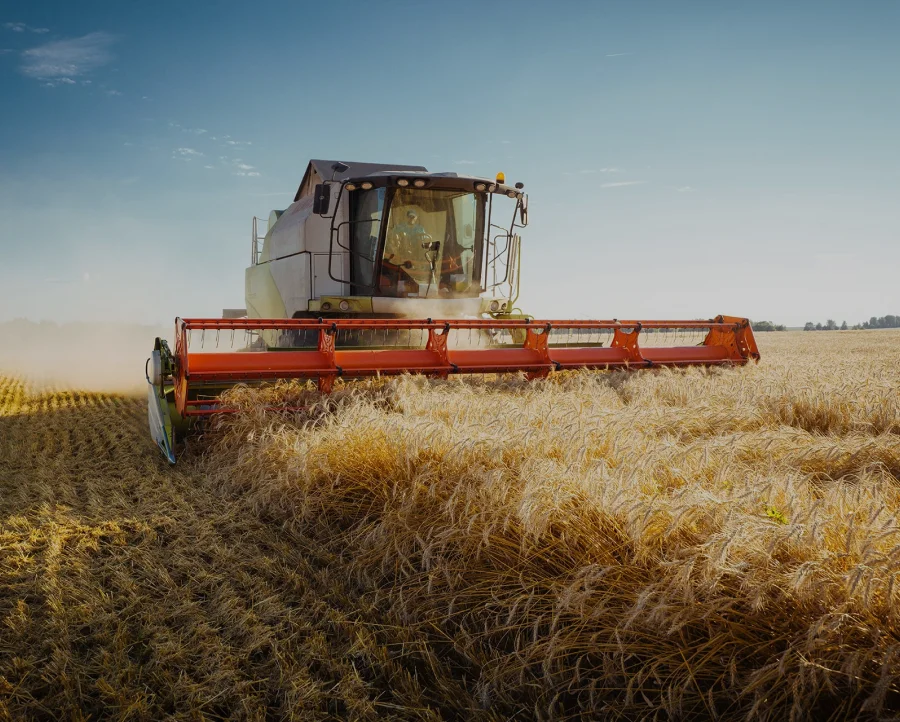Introduction
Managing financial risk in agriculture is fundamental for maintaining the sustainable growth of your farm. Financial risks are associated with agriculture due to various reasons, such as market variations, unpredictable weather conditions, and operational hurdles. These factors can have a huge impact on your farm’s performance. By comprehending and reducing these risks, you can have a secure financial future for your agricultural business.
Agriculture is risky due to factors that are beyond a farmer’s control. For instance, prices for agricultural products can vary a lot, as they are affected by global supply and demand.
Weather conditions, such as droughts, floods, and storms, can cause significant damage to crops and livestock. Operational hurdles, such as equipment failure and labor shortages, can further stress your financial resources.
Therefore proactive financial risk management enables farmers to have more control.
Understanding Financial Risk in Agriculture
Financial risk in agriculture refers to the possible financial losses due to different factors. These risks arise due to external economic triggers, such as natural disasters, and changes in consumer demand. For example, a sudden decline in market prices, droughts, or changes in consumer preference. Identifying these risks and their sources is the initial step towards good financial risk management in agriculture.
Multiple factors contribute to financial risk in agriculture:
- External Economic Conditions:
The price of agricultural inputs and products can be impacted by trade policy changes or economic recessions. The cost of borrowing money and buying products can also be affected by changes in interest rates and currency rates.
- Natural Disasters:
Agriculture is highly prone to natural disasters like hurricanes, earthquakes, and pest infestations. These natural calamities can destroy crops and livestock, leading to huge financial losses.
- Consumer Demand Shifts:
Changes in consumer choices and dietary trends can affect the demand for agricultural products. For example, a growing demand for organic products or plant-based diets can affect the profitability of traditional farming practices.
- Input Costs:
The prices of seeds, fertilizers, pesticides, and other inputs can vary from time to time. Unexpected rises in these costs can put stress on your budget and lower profits.
- Regulatory Changes:
New regulations related to environmental protection, labor, and food safety may need expensive changes to farming practices. Staying compliant with updated regulations is important but can add to financial risk.
Understanding these factors helps in devising strategies to reduce their impact and ensure improved financial health of your farm.
Key Strategies for Managing Financial Risk
Diversification
Diversification is one of the most effective strategies for managing financial risk in agriculture. By having a variety of crops, livestock, and agricultural activities, you can reduce dependency on a single source of income. If one crop fails or market prices drop, other sources of income can reduce the financial impact. Farmers must consider having different types of crops or livestock and initiating other activities like agritourism or value-added products.
As an example, a farm that grows both wheat and vegetables may still earn profits if wheat prices fall but vegetable prices remain stable. Likewise, having livestock along with crops can generate additional revenue and have benefits such as providing crop residues for animal feed.
Futures Contracts and Hedging
Hedging and futures contracts are effective strategies to manage market fluctuations. By fixing product pricing in advance, futures contracts help you lower the risk of price fluctuations. Taking a position in the futures market to cover any losses in the cash market is known as hedging. Both tactics are useful in protecting you from unfavorable market conditions and stabilizing your income.
For example, by making a futures contract, you can agree to sell your crop at a preset price at a future date. This protects you from the risk of price reductions before harvest. Hedging can be done through commodity exchanges where you sell futures contracts that match the quantity of your forecasted harvest. These strategies provide a level of certainty and allow you to plan your finances effectively.
Insurance
An essential part of agricultural financial risk management is insurance. There are many insurance options available for protecting against unexpected financial losses, including revenue insurance and crop insurance. Revenue insurance protects against drops in market prices or yields, whereas crop insurance covers losses caused by natural calamities like floods and droughts. Acquiring the appropriate insurance plans offers financial security.
Crop insurance covers a portion of your expected yield or revenue. If actual production falls below the insured level the insurance compensates for the shortfall. Revenue insurance integrates yield protection with price protection, making sure that your income remains stable even if both production and prices drop. The key to good risk management is identifying your risks and choosing the right insurance plans.
Financial Planning and Budget Control
Managing your farm’s finances requires a carefully planned budget. It’s important to anticipate future risks while developing an effective financial strategy. Set realistic financial goals and list all possible sources of income and costs. To reflect changes in the market and your business, assess and update your budget regularly. Good budget management guarantees that you can manage unexpected costs without affecting the sustainability of your farm.
Financial planning should include:
- Income Projections: Estimate your expected income from different sources, considering past data and market trends.
- Expense Management: Track all costs, including variable and fixed costs, and find methods to reduce them.
- Cash Flow Analysis: Monitor cash inflows and outflows to ensure liquidity.
- Contingency Funds: Make cash reserves for unexpected expenses or losses that can serve as a buffer during hard times.
Regular financial reviews can help you stay aligned with your budget and make intelligent decisions for financial health.
Investment in Technology
Investing in agricultural technology can improve financial outcomes by boosting efficiency and reducing waste. Modern technologies such as precision farming tools, automated equipment, and advanced data analytics can assist you make smart decisions, maximize resource use, and predict environmental changes.
For example, Precision farming uses GPS and sensors to apply fertilizers and pesticides accurately, reducing waste and increasing harvests. Automated machinery can perform tasks like planting and harvesting efficiently. This saves time and labor costs. Data analytics can assess weather patterns, soil conditions, and market trends and schedule tasks.
Using technology not only enhances productivity but also makes your farm more flexible to fluctuating conditions.
Building Strong Market Relationships
Securing steady income sources requires building strong relationships with suppliers and customers. Signing agreements with purchasers can lower revenue instability and guarantee a market for your goods. Good relations with suppliers may also result in more favorable loan conditions and consistent access to supplies. Developing a strong network in the agriculture industry might help your farm become more financially stable.
Long-term contracts with buyers lead to a steady demand for your products and price stability. Good relationships with suppliers can result in better payment terms and access to quality inputs. Connecting with farmer associations can also build your market position and provide collective bargaining power. Good communication and trust are key to maintaining these relationships and ensuring mutual benefits.
Regular Financial Assessment
Regular financial checks are important to assess the financial health of your business and spot possible issues early. These regular financial reviews help you see performance, analyze trends, and make adjustments. Use metrics like financial statements, cash flow analysis, and profitability ratios to get details regarding your farm’s finances. Proactive financial management empowers you to handle problems before they aggravate and ensures long-term stability.
Financial assessments must include:
- Balance Sheets: Analyze assets, liabilities, and equity to understand your farm’s financial position.
- Income Statements: Monitor income and expenses to gauge profitability.
- Cash Flow Statements: Trace cash flows to ensure liquidity and manage debt.
- Profitability Ratios: Calculate metrics like return on investment (ROI) to assess financial performance.
By monitoring these key indicators, you can identify trends, and issues, and take rectifying actions to maintain financial health.
Government Programs and Support
Multiple government programs are available to help agricultural businesses during the financial crunch. These programs offer financial help, subsidies, and disaster relief to reduce the impact of these unfortunate events. Acquaint yourself with the available resources and take advantage of these programs when needed. Government aid can provide a safety net and help you handle these tough financial times.
Programs such as the USDA’s Farm Service Agency (FSA) offer loans, grants, and insurance to support farmers. Disaster relief programs give emergency funding. Subsidies can provide income stability and reduce production costs. However, it’s important to know the criteria for eligibility and the application process for these programs to receive immediate help.
Learning from Case Studies
Let’s examine some success stories from across the globe of the farms that have successfully wavered off financial risks by implementing the techniques discussed above.
Take the example of a farm that diversified its operations by integrating crop production with livestock farming and agritourism. This reduced their dependence on a single income source and created multiple sources of revenue.
Another farm used futures contracts to lock in favorable prices for its produce, ensuring stable income despite market shifts.
Conclusion
Proactive financial risk management in agriculture is mandatory to guarantee the long-term profitability of your farm. By adopting financial strategies such as diversification, futures contracts, insurance, and investment in technology, you can reduce risks.
Moreover, regular financial analysis, strong market ties, and government support boost your capacity to tackle financial challenges.
Adopting a proactive approach to financial risk management empowers you to anticipate and prepare for uncertainties rather than reacting to crises.
To ensure the financial growth of your business, consider consulting professional financial advice personalized to your needs. Sign up for a webinar or consultation service targeted at
financial risk management in agriculture. Take control of your finances today to secure the long-term success of your farming business.









